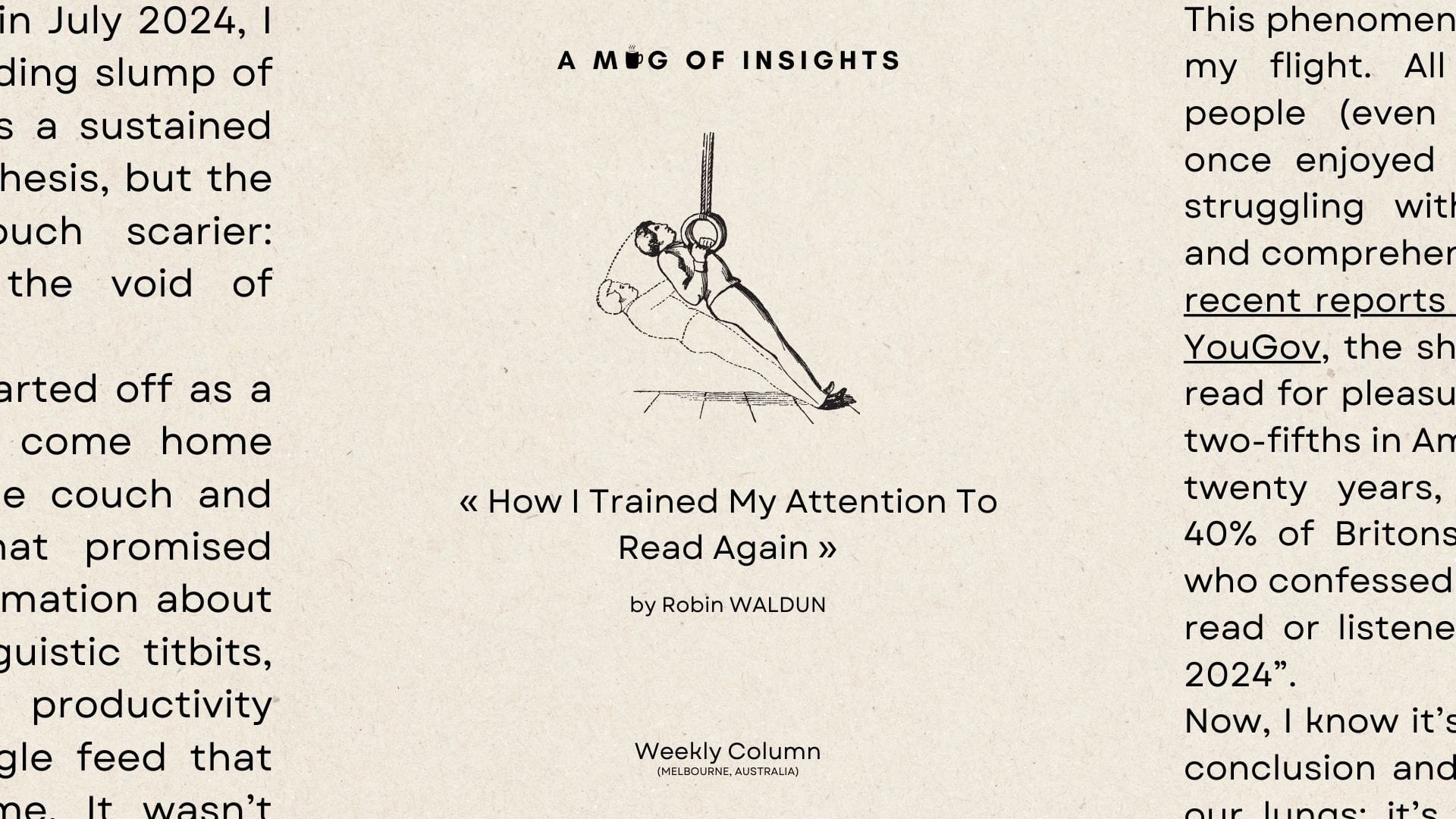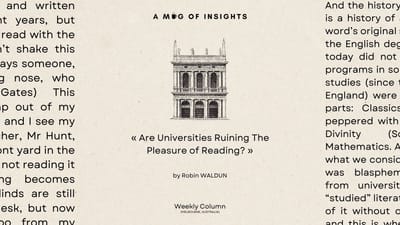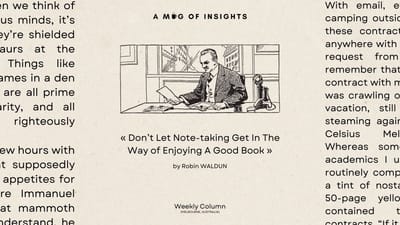How I Trained My Attention To Read Again

Welcome to the weekly column from A Mug of Insights! From now on, I'll dispatch these letters on Saturdays, and paid subscribers will receive their 1-2-Read letters on Mondays. If you like what you're reading, consider upgrading to the Grande tier for journal prompts and a practical exercise every week to strengthen your reading muscles! Thank you for reading, and I look forward to seeing you next week.
Update
If you're enjoying our weekly newsletters, then you'll also love the new season of our podcast under the same name! You can now listen to the show on Spotify, Apple Podcasts or wherever you get your pods!
When I graduated back in July 2024, I entered the biggest reading slump of my life. A part of it was a sustained burnout after writing a thesis, but the other part was a touch scarier: something else filled the void of reading.
Social media content started off as a nice diversion. I would come home from work, sink into the couch and stare into a portal that promised access to the best information about the world. I learned linguistic titbits, relationship advice and productivity hacks, all from one single feed that was curated just for me. It wasn’t particularly hard to put it down and get back to something else, and it felt like the perfect break from 5 years of toiling with difficult books. However, this honeymoon was short-lived.
When I left for London back in February to sort out a contract with my publisher, I packed a novel to read on the plane. Imagine: 22 hours of flight time with no distractions, no internet, just a long book and my own thoughts. It was the ideal setting for regaining some of those fond memories of getting drunk off hours of reading. But when I boarded the plane and cracked open the first chapter of Sentimental Education, I realised that I could no longer focus. After half an hour of struggling with walls of flowery description, I had to put the book down and sleep through the rest of the flight with 10 podcast episodes playing back-to-back in my ears.
This phenomenon is not unique to my flight. All over the world, people (even those who have once enjoyed reading) are now struggling with basic attention and comprehension. According to recent reports from iScience and YouGov, the share of people who read for pleasure has dropped by two-fifths in America over the last twenty years, accompanied by 40% of Britons across the pond who confessed that they “had not read or listened to any books in 2024”.
Now, I know it’s easy to jump to a conclusion and yell at the top of our lungs: it’s the dang phones! But I think there’s a deeper layer here. The problem with most of these doom-and-gloom outcries about the decline of literacy is that they don’t address how our relationship with information has changed. They automatically assume: books = good, social media = bad, while refusing to acknowledge the real cause behind why people no longer read books: short-form content (written or audiovisual) seems to offer alternatives for entertainment and information compared to the slow burn of a 300-page novel or a 10,000-word coverage in a magazine. Our baseline has changed from viewing print media as the default to seeing it as just another information alternative, albeit a more demanding one. If given the choice, any Joe Schmo would leap at the opportunity to get their information with a fraction of the time, rendering long-form reading a quaint, bygone luxury.
In other words, we can’t simply assign some special, transcendental value to reading books and call it a day. If we really want to bring back long-form reading, we need to articulate a better reason for people to reinvest their time/energy into staying with the words on the page.
Not all reading is created equal
Whenever people complain about how no one reads anymore, I’ll take them to the subway, sit them down and ask them to look around them. There might be a few people watching videos with their volumes turned up high, but the vast majority of people are reading something. The news, emails, text messages or captions on social media posts. According to an estimate in 2017 , the average smartphone user in the USA averages a whopping 62,250 words per day from reading on their phones. That’s like reading To the Lighthouse or The Catcher in the Rye in a single day! We’re exposed to more information than ever at a fraction of the speed, yet intuitively, none of us feel any smarter, because not all reading is created equal.
Byung-Chul Han observed in his book, Infocracy, that the reason why we’re just as confused and aimless after reading so much during the day is that:
“Today, we may be well informed, but we lack orientation. Information does not have the power to provide orientation (p. 52).”
In other words, scattered information does not organise our experiences in any meaningful way, since “information is additive and cumulative”. Knowledge, by contrast, is “narrative and exclusive.” This is why long-form writing provides something information cannot: a highly selective narration that helps us make sense of the world.
In addition, a sustained narrative builds the stamina for us to stay with an idea and follow through. It encourages us to suspend disbelief and hold contradictions without falling apart. This, in Cal Newport’s words, is callisthenics for our brains, and it’s the cornerstone of intelligence and reasoning skills. And when we replace most, if not all, sustained reading with quick bursts of information, our intelligence suffers as a result.
The Reverse-Flynn Effect
In a recent study published in the journal ‘Intelligence’ in 2023, researchers at Northwestern University compiled IQ test data from a large sample of US adults between 2006-2018 to see if the Flynn Effect hypothesis still holds up.
In short, the Flynn Effect argues that every generation gets a little smarter than the one before, with an average rise of 3.0 to 5.0 IQ points per decade since 1932 and throughout the 20th Century. However, after crunching data from 394,378 participants over trash cans filled with empty coffee cups, the results suggested an alarming trend.
Out of all the intelligence metrics (excluding spatial reasoning, which observed a slight increase), the increase in intelligence was nowhere near the 3.0 to 5.0 IQ points originally observed by Flynn, while more recent participants (18-22-year-olds) actually exhibited lower scores compared to the previous generation. In the words, there was possible evidence for a reverse Flynn effect where intelligence regressed over time. And according to the data, this reversal started right around the 2010s when smartphones became ubiquitous.
This isn’t to say the dang phones are the sole culprits, but the devices did seem to encourage a particular relationship reading. One, information has to be immediate and curated by an algorithm. Two, the smaller screens fostered an incentive for compact, short paragraphs compared to an A4 spread of visual real estate. And three: for people from 18-22 who did not grow up in a print-dominated culture, long-form reading is seen as a time-sink and a quaint alternative. All these are possible explanations for this attitude change towards long & sustained reading, and as a result, our brains are no longer prepared for long and demanding material.
The analogy that broke me out of my reading slump
So, yes. The research is pretty bleak, and so were the first few months after I got home from London. I tried to channel every nerve in my body to get back my 3-hour-long focus stretch, but it didn’t work. My reading progress dipped from two books a week to one book every two months. And just when I thought everything was doomed, I read an article that changed everything.
It was a newsletter from 2024 by Cal Newport titled “On-Ultra Processed Content”. He argued that short-form content is essentially a digital Dorito, where substantial, long-form knowledge is broken down into its base elements, then recombined into “hyper-palatable combinations”. Whereas material that requires more effort to read: books, articles and novels, are like minimally processed whole foods; something we’ve “worked with for over 5,000 years”.
See, if no one will raise an objection when you say no, thank you to a bag of Doritos, then why should our reading diets be any different? Why have we allowed ultra-processed content to become the default diet while seeing minimally processed content as just an antiquated alternative?
I realised that my default needs to change and went on a digital diet to rewire my defaults. I explained this diet in this long post here, but in short, I replaced my newsfeed with long-form magazine articles and YouTube videos with books on the same subjects. And just like any diet, the first few weeks were rough. Sometimes I sat around with nothing to do and dipped in and out of books that were around the house. However, during week 3, something clicked.
I went to a bookshop one evening with my e-ink tablet and wanted to pick up a few reference books for a chapter I was writing. But when I saw that the café was still open, I thought, what the hell, sat down and started leafing through some of the articles I saved on my tablet. Then, an hour passed, then another, then people started packing up the chairs around me, and I realised that I had reached the end of a lengthy Reporter at Large instalment from the latest New Yorker issue. I checked my phone: 8:00 pm. It meant that I had sat around for three hours with print articles.
The drive home that night felt quieter. My mind was mulling over all the ideas from those articles, and instead of feeling anxious or skippy, my thoughts branched out in a long, steady stretch until I reached the driveway. Then, I walked into my bedroom, sat down, and a novel was waiting for me on my nightstand. Only this time, I no longer have to worry about a wandering mind because attention has become a default, not a forced effort.
Until next week
Robin
Subscribe to my newsletter to get the latest updates and news




Member discussion